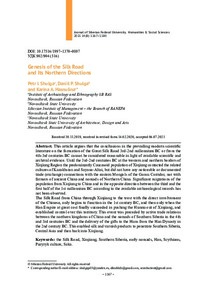Показать сокращенную информацию
Genesis of the Silk Road and Its Northern Directions
| Автор | Shulga, Petr I. | en |
| Автор | Shulga, Daniil P. | en |
| Автор | Hasnulina, Karina A. | en |
| Автор | Шульга, П. И. | ru_RU |
| Автор | Шульга, Д. П. | ru_RU |
| Автор | Хаснулина, К. А. | ru_RU |
| Дата внесения | 2021-08-31T09:42:45Z | |
| Дата, когда ресурс стал доступен | 2021-08-31T09:42:45Z | |
| Дата публикации | 2021-08 | |
| URI (для ссылок/цитирований) | https://elib.sfu-kras.ru/handle/2311/143565 | |
| Аннотация | This article argues that the conclusions in the prevailing modern scientific literature on the formation of the Great Silk Road 3rd‑2nd millennium BC or from the 4th‑3rd centuries BC cannot be considered reasonable in light of available scientific and archival evidence. Until the 3rd‑2nd centuries BC at the western and northern borders of Xinjiang Region the predominantly Caucasoid population of Xinjiang contacted the related cultures of Kazakhstan and Sayano-Altai, but did not have any noticeable or documented trade (exchange) connections with the eastern Mongols of the Gansu Corridor, nor with farmers of ancient China and nomads of Northern China. Significant migrations of the population from Xinjiang to China and in the opposite direction between the third and the first half of the 1st millennium BC according to the available archaeological records has not been observed. The Silk Road from China through Xinjiang to the west with the direct involvement of the Chinese, only begins to function in the 1st century BC, and then only when the Han Empire at great cost finally succeeded in pushing the Hunnu out of Xinjiang, and established control over this territory. This event was preceded by active trade relations between the northern kingdoms of China and the nomads of Southern Siberia in the 4th and 3rd centuries BC and the delivery of the gifts to the Huns from the Han Dynasty in the 2nd century BC. This enabled silk and varnish products to penetrate Southern Siberia, Central Asia and then back into Xinjiang | en |
| Аннотация | Авторы приходят к заключению, что широко распространённые в русскоязычной и зарубежной научной литературе мнения о формировании Великого Шёлкового пути, начиная с III–II тыс. до н. э., или с VI–III вв. до н. э., нельзя считать обоснованными. До III–II вв. до н. э. преимущественно европеоидное население Синьцзяна контактировало на западных и северных границах с родственными культурами Казахстана и Саяно-Алтая, но не имело сколько-нибудь заметных и документированных торговых (обменных) связей с расположенными к востоку монголоидами Ганьсуйского коридора, земледельцами Древнего Китая и кочевниками Северного Китая. Значительных миграций населения из Синьцзяна в Китай и в обратном направлении в III – первой половине I тыс. до н. э. по археологическим материалам не наблюдается. Собственно Шёлковый путь из Китая через Синьцзян на запад при непосредственном участии китайцев начинает функционировать только в I в. до н. э., когда империи Хань ценой больших усилий удаётся оттеснить хунну из Синьцзяна и установить контроль над данной территорией. Этим событиям предшествовали активные торговые отношения северных царств Китая с кочевниками Южной Сибири в IV– III вв. до н. э. и поставки хуннам «даров» из Хань во II в. до н. э., посредством которых шёлк и лаковые изделия проникали в Южную Сибирь, Среднюю Азию и кружным путём в Синьцзян | ru_RU |
| Язык | en | en |
| Издатель | Сибирский федеральный университет. Siberian Federal University | en |
| Тема | the Silk Road | en |
| Тема | Xinjiang | en |
| Тема | Southern Siberia | en |
| Тема | early nomads | en |
| Тема | Han | en |
| Тема | Scythians | en |
| Тема | Pazyryk culture | en |
| Тема | Saka | en |
| Тема | Великий Шёлковый путь | ru_RU |
| Тема | Синьцзян | ru_RU |
| Тема | Южная Сибирь | ru_RU |
| Тема | ранние кочевники | ru_RU |
| Тема | империя Хань | ru_RU |
| Тема | скифоидные культуры | ru_RU |
| Тема | пазырыкская культура | ru_RU |
| Тема | саки | ru_RU |
| Название | Genesis of the Silk Road and Its Northern Directions | en |
| Альтернативное название | О становлении Шелкового пути и его северных направлениях | ru_RU |
| Тип | Journal Article | en |
| Контакты автора | Shulga, Petr I.: Institute of Archaeology and Ethnography SB RAS Novosibirsk, Russian Federation; shulgapi55@yandex.ru | en |
| Контакты автора | Shulga, Daniil P.: Novosibirsk State University Siberian Institute of Management – the Branch of RANEPA Novosibirsk, Russian Federation; alkaddafa@gmail.com | en |
| Контакты автора | Hasnulina, Karina A.: Novosibirsk State University Novosibirsk State University of Architecture, Design and Arts Novosibirsk, Russian Federation; searchorient@gmail.com | en |
| Контакты автора | Шульга, П. И.: Институт археологии и этнографии СО РАН Российская Федерация, Новосибирск | ru_RU |
| Контакты автора | Шульга, Д. П.: Новосибирский государственный университет Сибирский институт управления – филиал РАНХиГС Российская Федерация, Новосибирск | ru_RU |
| Контакты автора | Хаснулина, К. А.: Новосибирский государственный университет Новосибирский государственный университет архитектуры, дизайна и искусств Российская Федерация, Новосибирск | ru_RU |
| Страницы | 1167–1180 | ru_RU |
| DOI | 10.17516/1997-1370-0807 | |
| Журнал | Журнал Сибирского федерального университета. Гуманитарные науки. Journal of Siberian Federal University. Humanities & Social Sciences; 2021 14 (8) | en |

